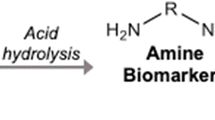Abstract
1,3-Butadiene and acrylonitrile are important industrial chemicals that have a high production volume and are ubiquitous environmental pollutants. The urinary mercapturic acids of 1,3-butadiene and acrylonitrile—N-acetyl-S-(3,4-dihydroxybutyl)cysteine (DHBMA) and MHBMA (an isomeric mixture of N-acetyl-S-((1-hydroxymethyl)-2-propenyl)cysteine and N-acetyl-S-((2-hydroxymethyl)-3-propenyl)cysteine) for the former and N-acetyl-S-2-cyanoethylcysteine (CEMA) for the latter—are specific biomarkers for the determination of individual internal exposure to these chemicals. We have developed and validated a fast, specific, and very sensitive method for the simultaneous determination of DHBMA, MHBMA, and CEMA in human urine using an automated multidimensional LC/MS/MS method that requires no additional sample preparation. Analytes are stripped from urinary matrix by online extraction on a restricted access material, transferred to the analytical column, and subsequently determined by tandem mass spectrometry using labeled internal standards. The limits of quantification (LOQs) for DHBMA, MHBMA, and CEMA were 10 µg/L, 2 µg/L, and 1 µg/L urine, respectively, and were sufficient to quantify the background exposure of the general population. Precision within series and between series for all analytes ranged from 5.4 to 9.9%; mean accuracy was between 95 and 115%. We applied the method on spot urine samples from 210 subjects from the general population with no occupational exposure to 1,3-butadiene or acrylonitrile. A background exposure of the general population to acrylonitrile was discovered that is basically influenced by individual exposure to passive smoke as well as active smoking habits. Smokers showed a significantly higher excretion of MHBMA, whereas DHBMA levels did not differ significantly. Owing to its automation, our method is well suited for application in occupational or environmental studies.

Boxplots of the results from LC/ESI-MS/MS analysis of urinary excretion of CEMA reveal a strong correlation with nicotine metabolite cotinine, indicating that exposure to passive smoke as well as active smoking is the main source of exposure to acrylonitrile in the general population







Similar content being viewed by others
References
US Department of Health and Human Services, Public Health Service, National Toxicology Program (2008) 1,3-Butadiene. In: Report on carcinogens, 11th edn. http://ntp.niehs.nih.gov/ntp/roc/eleventh/profiles/s025buta.pdf. Accessed 27 July 2008
DFG (Deutsche Forschungsgemeinschaft) (2007) List of MAK- and BAT-values 2007. Wiley-VCH, Weinheim
IARC (1999) IARC Monograph Eval Carcinog Risks Hum 71:109–227
Kim SR, Dominici F, Buckley TJ (2007) Environ Res 105:291–299
Tang S, Frank BP, Lanni T, Rideout G, Meyer N, Beregszaszy C (2007) Environ Sci Technol 41:5037–5041
Brunnemann KD, Kagan MR, Cox JE, Hoffmann D (1990) Carcinogenesis 11:1863–1888
Adam T, Mitschke S, Streibel T, Baker RR, Zimmermann R (2006) Chem Res Toxicol 19:511–520
Boogaard PJ, vanSittert NJ, Megens HJ (2001) Chem Biol Interact 135–136:695–701
McDonald JD, Bechtold WE, Krone JR, Blackwell WB, Kracko DA, Henderson RF (2004) J Anal Toxicol 28:168–173
Henderson RF, Thornton-Munning JR, Bechtold WE, Dahl AR (1996) Toxicology 113:17–22
Albertini RJ, Sram RJ, Vacek PM, Lynch J, Wright M, Nicklas JA, Boogaard PJ, Henderson RF, Swenberg JA, Tates AD, Ward JB (2001) Chem Biol Interact 135–136:429–453
Albertini RJ, Sram RJ, Vacek PM, Lynch J, Rossner P, Nicklas JA, McDonald JD, Boysen G, Georgieva N, Swenberg JA (2007) Chem Biol Interact 166:63–77
Sapkota A, Halden RU, Dominici F, Groopman JD, Buckley TJ (2006) Chem Biol Interact 160:70–79
Urban M, Gilch G, Schepers G, van Miert E, Scherer G (2003) J Chromatogr B 796:131–140
van Sittert NJ, Megens HJ, Watson WP, Boogaard PJ (2000) Toxicol Sci 56:189–202
Fustinoni S, Perbellini L, Soleo L, Manno M, Foa V (2004) Toxicol Lett 149:353–360
US Department of Health and Human Services, Public Health Service, National Toxicology Program (2008) Acrylonitrile. In: Report on carcinogens, 11th edn. http://ntp.niehs.nih.gov/ntp/roc/eleventh/profiles/s004acry.pdf. Accessed 27 July 2008
IARC (1999) IARC Monograph Eval Carcinog Risks Hum 71:43–109
Collins JJ, Acquavella JF (1998) Scand J Work Environ Health 24(Suppl. 2):63–70
Office for Official Publications of the European Communities (2004) European Union risk assessment report: acrylonitrile. http://europa.eu.int. Accessed 27 July 2008
Hoffmann D, Hoffmann I, El-Bayoumy K (1997) Chem Res Toxicol 14:767–790
Schettgen T, Broding HC, Angerer J, Drexler H (2002) Toxicol Lett 134:65–70
Fennell TR, MacNeela JP, Morris RW, Watson M, Thompson CL, Bell DA (2000) Cancer Epidemiol Biomarker Prev 9:705–712
Bergmark E (1997) Chem Res Toxicol 10:78–84
Perez HL, Segerbäck D, Ostermann-Golkar S (1999) Chem Res Toxicol 12:869–873
Ostermann-Golkar SM, MacNeela JP, Turner MJ, Walker VE, Swenberg JA, Sumner SJ, Youtsey N, Fennell TR (1994) Carcinogenesis 15:2701–2707
Lewalter J (1996) Int Arch Occup Environ Health 68:519–530
van Sittert NJ (1996) N-2-cyanoethylvaline, N-2-hydroxyethylvaline, N-methylvaline in blood. In: Angerer J, Schaller KH (eds) Analyses of hazardous substances in biological materials, vol 6. Wiley-VCH, Weinheim
Sumner SCJ, Selvaraj L, Nauhaus SK, Fennell TR (1997) Chem Res Toxicol 10:1152–1160
Jakubowski M, Linhart I, Pielas G, Kopecky J (1987) Br J Ind Med 44:834–840
Boogaard PJ (2008) Occup Environ Med 65:221–222
Larsen K (1972) Clin Chim Acta 41:209–217
Müller M (2001) Cotinine. In: Angerer J, Schaller KH (eds) Analyses of hazardous substances in biological materials, vol 8. Wiley-VCH, Weinheim
Scherer G (1999) Cotinine. In: Angerer J, Schaller KH (eds) Analyses of hazardous substances in biological materials, vol 7. Wiley-VCH, Weinheim
Schettgen T, Musiol A, Alt A, Kraus T (2008) J Chromatogr B 863:283–292
Bentayeb K, Batlle R, Sanchez C, Nerin C, Domeno C (2008) J Chromatogr B 869(1–2):1–8
Acknowledgement
The authors would like to thank Ms. Kathy Bischof for kindly reviewing this manuscript and Ms. Kerstin Gerards for skilful analysis of urinary creatinine.
Author information
Authors and Affiliations
Corresponding author
Rights and permissions
About this article
Cite this article
Schettgen, T., Musiol, A., Alt, A. et al. A method for the quantification of biomarkers of exposure to acrylonitrile and 1,3-butadiene in human urine by column-switching liquid chromatography–tandem mass spectrometry. Anal Bioanal Chem 393, 969–981 (2009). https://doi.org/10.1007/s00216-008-2510-1
Received:
Revised:
Accepted:
Published:
Issue Date:
DOI: https://doi.org/10.1007/s00216-008-2510-1




